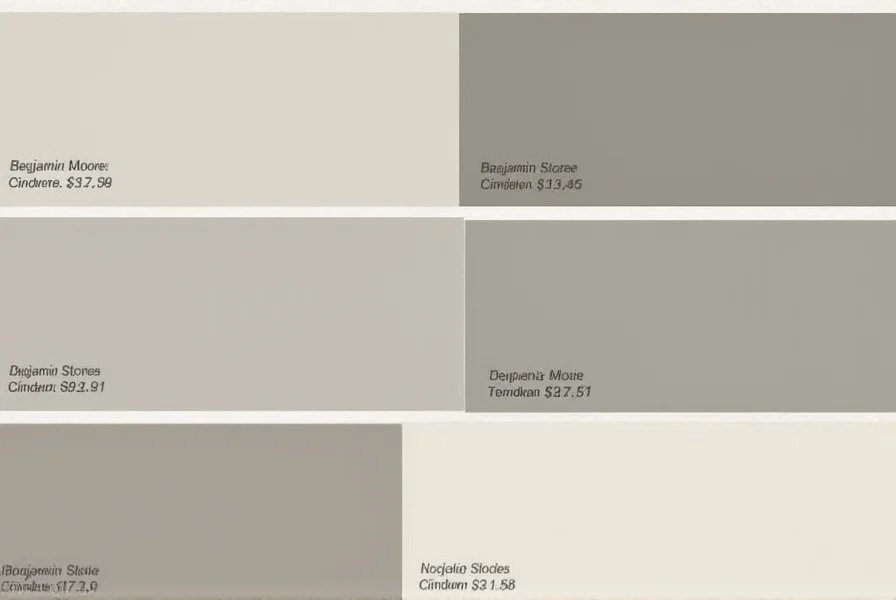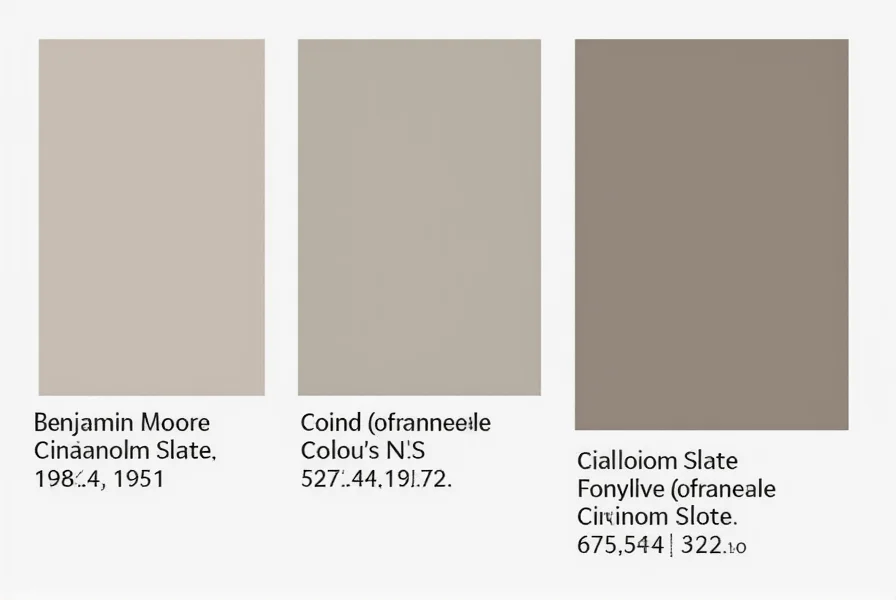When selecting a paint color that balances warmth and sophistication, Benjamin Moore Cinnamon Slate (HC-73) consistently emerges as a top choice among interior designers and homeowners. This warm gray with subtle taupe undertones creates a welcoming environment without feeling cold or sterile—a common issue with many grays on the market. The color's unique composition allows it to shift slightly depending on lighting conditions, appearing more taupe in north-facing rooms and taking on a cooler gray cast in south-facing spaces with abundant natural light.
Understanding the specific characteristics of Benjamin Moore Cinnamon Slate requires examining its technical specifications. With an LRV (Light Reflectance Value) of 29.37, this color falls in the medium-dark range, absorbing rather than reflecting significant light. The official RGB values are R:175, G:163, B:151, while the hex code is #AF9F97. These technical details help explain why Cinnamon Slate creates such a cozy atmosphere—it's dark enough to feel enveloping but light enough to maintain brightness in properly lit spaces.
| Color Specification | Value |
|---|---|
| Benjamin Moore Code | HC-73 |
| LRV (Light Reflectance Value) | 29.37 |
| RGB Values | R:175, G:163, B:151 |
| Hex Code | #AF9F97 |
| Undertone | Warm taupe-gray |
One of the most valuable aspects of Cinnamon Slate is how lighting dramatically affects its appearance. In rooms with northern exposure, the color reveals more of its taupe undertones, creating a warmer, earthier feel. Southern exposure brings out the gray elements, making the color appear more neutral. Artificial lighting also plays a crucial role—warm white bulbs (2700K-3000K) enhance the cozy taupe qualities, while cooler bulbs (3500K+) emphasize the gray base. This adaptability makes Benjamin Moore Cinnamon Slate suitable for virtually any room in the home when properly tested in the actual space.
When considering where to apply Cinnamon Slate in your home, living rooms and bedrooms prove particularly successful. The color's medium depth creates an intimate atmosphere perfect for relaxation spaces without making rooms feel smaller—a common concern with darker paints. For kitchens, Cinnamon Slate works beautifully as an island color against lighter cabinetry or as an accent wall behind open shelving. Many designers recommend using it in home offices where its calming properties can enhance focus without being stimulating.
Pairing colors with Cinnamon Slate requires understanding its warm undertones. Pure white trim can sometimes appear too stark, so off-whites with warm undertones like Benjamin Moore White Dove (OC-17) or Cloud White (OC-130) create more harmonious transitions. For complementary colors, consider:
- Deep navy blues for dramatic contrast
- Warm metallics like brass and gold
- Earthy greens that pick up the taupe elements
- Cream and beige textiles for soft contrast
When comparing Benjamin Moore Cinnamon Slate to similar popular colors, several distinctions emerge. Unlike Windswept Smoke (CC-30), which has cooler blue undertones, Cinnamon Slate maintains consistent warmth. It's deeper and warmer than Revere Pewter (HC-170), making it better suited for creating cozy spaces. Compared to Sherwin-Williams Agreeable Gray (SW 7029), Cinnamon Slate has more pronounced taupe elements and less beige influence.
Professional painters recommend specific application techniques for optimal results with Cinnamon Slate. Always test the color on multiple walls in your space, observing it at different times of day. Consider using a satin or eggshell finish in high-traffic areas for durability while maintaining a soft sheen that enhances the color's depth. For the most accurate representation, view samples under the same lighting conditions as your finished space—many homeowners make the mistake of evaluating samples in retail lighting that doesn't match their home environment.

One common question about Benjamin Moore Cinnamon Slate involves its performance in small or dark rooms. While its medium-dark value might seem challenging for limited spaces, proper lighting design can make it work beautifully. Strategically placed lighting fixtures, reflective surfaces, and careful furniture selection can prevent the color from feeling overwhelming. In fact, many designers find that using Cinnamon Slate in smaller spaces creates a jewel-box effect that feels luxurious rather than cramped.
The enduring popularity of Cinnamon Slate stems from its versatility across design styles. It works equally well in modern minimalist spaces, traditional settings, and eclectic interiors. In farmhouse designs, it provides a sophisticated alternative to standard grays while maintaining that sought-after cozy feel. For contemporary spaces, it offers depth without overwhelming the clean lines that define the style. This adaptability explains why interior designers continue recommending Benjamin Moore Cinnamon Slate years after its introduction.
What are the undertones of Benjamin Moore Cinnamon Slate?
Benjamin Moore Cinnamon Slate features warm taupe undertones with a subtle gray base. Unlike many grays that have cool blue or purple undertones, Cinnamon Slate maintains consistent warmth that works well in most lighting conditions. The taupe element becomes more pronounced in north-facing rooms with cooler light, while the gray base shows more in south-facing spaces with abundant natural light.
What's the best trim color to pair with Cinnamon Slate?
For the most harmonious look with Benjamin Moore Cinnamon Slate, choose warm off-white trim colors rather than pure white. Benjamin Moore White Dove (OC-17) and Cloud White (OC-130) work exceptionally well as they share similar warm undertones. Avoid cool whites which can create an unpleasant contrast with Cinnamon Slate's warm taupe base. The slight warmth in these off-whites creates a seamless transition between wall and trim.
How does Cinnamon Slate compare to Windswept Smoke?
While both are popular Benjamin Moore warm grays, Cinnamon Slate (HC-73) and Windswept Smoke (CC-30) have distinct differences. Cinnamon Slate has more pronounced taupe undertones and appears warmer overall, while Windswept Smoke has subtle blue undertones that make it appear cooler. Cinnamon Slate is slightly darker with an LRV of 29.37 compared to Windswept Smoke's 32.85. Cinnamon Slate works better in spaces where you want a cozier atmosphere, while Windswept Smoke suits spaces needing a touch more brightness.
Is Cinnamon Slate suitable for a north-facing room?
Yes, Benjamin Moore Cinnamon Slate works well in north-facing rooms, though it will appear warmer and more taupe than in south-facing spaces. North light tends to be cooler, which brings out the earthy taupe elements in Cinnamon Slate. Many designers prefer this effect as it creates a cozy, inviting atmosphere in rooms that might otherwise feel cold. Just ensure you have adequate artificial lighting to prevent the color from appearing too dark during shorter winter days.
What finish works best with Cinnamon Slate?
For Benjamin Moore Cinnamon Slate, satin or eggshell finishes typically work best. These finishes provide a soft sheen that enhances the color's depth without being overly reflective. In high-traffic areas like hallways or children's rooms, satin offers better durability and cleanability. For living rooms and bedrooms where a more subtle look is desired, eggshell provides a beautiful, velvety finish that showcases the complexity of Cinnamon Slate's undertones. Avoid flat finishes with this color as they can make the walls appear flat and one-dimensional.











 浙公网安备
33010002000092号
浙公网安备
33010002000092号 浙B2-20120091-4
浙B2-20120091-4